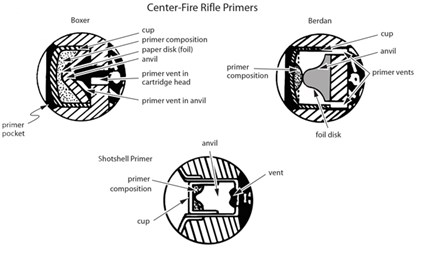Our Federal Primers Statements
Table of ContentsGetting My Small Pistol Primers To WorkThe Only Guide to Cci PrimersUnknown Facts About Remington PrimersGetting My Reloading Primers To WorkThe 3-Minute Rule for Pistol Primers
Part of the weapon cartridge for launching propellant combustion In firearms and also artillery, the guide () is the chemical and/or device in charge of initiating the propellant combustion that will certainly push the projectiles out of the gun barrel. In very early black powder weapons such as muzzleloaders, the guide was essentially the same chemical as the major propellant (albeit normally in a finer-powdered type), but put right into an external flash frying pan, where it might be stired up by an ignition source such as a slow match or a flintlock Some muzzleloaders have primers like cap weapon caps.
In weapons the guides are frequently a separate element, put inside the barrel to the back of the major propellant chargebut there are other instances of guns, consisting of for instance some automated tools, designed to fire cartridges with integral electric guides.
Rumored Buzz on Primers In Stock

This hole was filled up with finely ground powder, which was then stired up with a hot coal or lantern. With the arrival of hand-held weapons, this came to be an unfavorable means of firing a weapon. Holding a burning stick while trying to pour a cost of black powder meticulously down a barrel threatens, and trying to hold the weapon with one hand while simultaneously focusing on the target and seeking the touchhole makes it really difficult to fire precisely. [] The very first effort to make the process of shooting a small arm less complicated was the "matchlock".
, and also dried. After the weapon was packed as well as the touchhole primed with powder, the burning suggestion of the suit was placed so that the lock would bring it into call with the touchhole.
Rumored Buzz on Primers For Sale
This brought the match down to the touchhole, stiring up the powder. With cautious attention, the slow-burning match can be maintained melting for extended periods of time, as well as the use of the lock device made fairly accurate fire feasible. The next transformation in ignition technology was the "wheel-lock". It made use of a spring-loaded, serrated wheel which massaged versus a piece of iron pyrite, similar to a modern-day lighter.

The protected flashpan also supplied some capacity to endure poor weather. primers for sale. Wind, rainfall, and also wet weather condition would certainly render a matchlock worthless, but a wheel-lock that was loaded and also waterproofed with a little grease around the flashpan can be terminated under many conditions. The wheel-lock appreciated only a brief period of appeal before being superseded by a less complex, a lot more robust style.
Not known Details About Small Pistol Primers
As the name implies, the flintlock utilized flint instead of iron pyrite. The flint was kept in a spring-loaded arm, called the "penis" from the resemblance of its movement to a pecking poultry. The dick rotated through around a 90-degree arc as well as was kept in the tensioned, or "cocked" position by a trigger. https://is.gd/ogNBNd.
The "half-cock" setting held the cock midway back, and utilized a deep click here for info notch to make sure that pulling the trigger would not release the penis. Half-cock was a safety and security placement, made use of when filling, keeping or bring a packed flintlock. The "full-cock" position held the dick completely back and also was the setting from which the weapon was terminated.
It functioned as both a flashpan cover and also a steel striking surface area for the flint. The frizzen was pivoted as well as spring-loaded to make sure that it would lock in the open or closed placement. When closed, the striking surface area was positioned to make sure that the flint would strike at the appropriate angle to create a spark.
Little Known Questions About Cci Primers.
The flintlock mechanism was easier as well as stronger than the wheel-lock, as well as the flint and steel supplied an excellent, reliable resource of ignition. The flintlock stayed in army service for over 200 years, and also flintlocks are still made today for historical re-enactments and also muzzle-loading target competition, as well as for hunters that take pleasure in the added challenge that the flintlock supplies.
Percussion ignition was developed by Scottish clergyman Rev. Alexander John Forsyth in 1807 yet required further improvements prior to it was gradually accepted in the 1820s to 1830s. By the center of the 19th century, the percussion or caplock system was well established. It was embraced by both sides in the American Civil War, as it was simpler and also a lot more reputable than the flintlock.
The flashpan and frizzen were eliminated and also replaced by a tiny, hollow horizontal cyndrical tube (drum) screwed into the bored-out as well as tapped flash opening and bring a "nipple area" over which the cap could be fitted. A "hammer" which also had half-cock (for loading and also applying the cap) as well as full-cock settings replaced the cock.